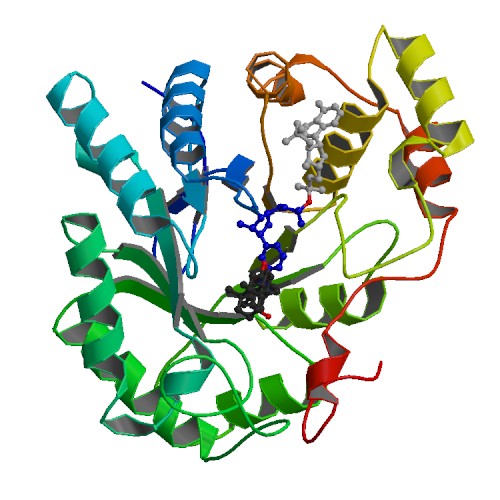AKR1C1
| Aldo-keto reductase family 1, member C1 (dihydrodiol dehydrogenase 1; 20-alpha (3-alpha)-hydroxysteroid dehydrogenase) | |||||||||||||
|---|---|---|---|---|---|---|---|---|---|---|---|---|---|
 PDB rendering based on 1ihi. | |||||||||||||
| |||||||||||||
| Identifiers | |||||||||||||
| Symbols | AKR1C1 ; C9; 2-ALPHA-HSD; 20-ALPHA-HSD; DD1; DDH; DDH1; H-37; HAKRC; MBAB; MGC8954; DD; AKR1C-pseudo; BABP; DD2; DDH2; HAKRD; HBAB; MCDR2 | ||||||||||||
| External IDs | Template:OMIM5 Template:MGI HomoloGene: 84695 | ||||||||||||
| |||||||||||||
| RNA expression pattern | |||||||||||||
 | |||||||||||||
 | |||||||||||||
 | |||||||||||||
| More reference expression data | |||||||||||||
| Orthologs | |||||||||||||
| Template:GNF Ortholog box | |||||||||||||
| Species | Human | Mouse | |||||||||||
| Entrez | n/a | n/a | |||||||||||
| Ensembl | n/a | n/a | |||||||||||
| UniProt | n/a | n/a | |||||||||||
| RefSeq (mRNA) | n/a | n/a | |||||||||||
| RefSeq (protein) | n/a | n/a | |||||||||||
| Location (UCSC) | n/a | n/a | |||||||||||
| PubMed search | n/a | n/a | |||||||||||
Aldo-keto reductase family 1, member C1 (dihydrodiol dehydrogenase 1; 20-alpha (3-alpha)-hydroxysteroid dehydrogenase), also known as AKR1C1, is a human gene.[1]
This gene encodes a member of the aldo/keto reductase superfamily, which consists of more than 40 known enzymes and proteins. These enzymes catalyze the conversion of aldehydes and ketones to their corresponding alcohols by utilizing NADH and/or NADPH as cofactors. The enzymes display overlapping but distinct substrate specificity. This enzyme catalyzes the reaction of progesterone to the inactive form 20-alpha-hydroxy-progesterone. This gene shares high sequence identity with three other gene members and is clustered with those three genes at chromosome 10p15-p14.[1]
References
Further reading
- Ciaccio PJ, Jaiswal AK, Tew KD (1994). "Regulation of human dihydrodiol dehydrogenase by Michael acceptor xenobiotics". J. Biol. Chem. 269 (22): 15558–62. PMID 7515059.
- Khanna M, Qin KN, Cheng KC (1995). "Distribution of 3 alpha-hydroxysteroid dehydrogenase in rat brain and molecular cloning of multiple cDNAs encoding structurally related proteins in humans". J. Steroid Biochem. Mol. Biol. 53 (1–6): 41–6. PMID 7626489.
- Khanna M, Qin KN, Klisak I; et al. (1995). "Localization of multiple human dihydrodiol dehydrogenase (DDH1 and DDH2) and chlordecone reductase (CHDR) genes in chromosome 10 by the polymerase chain reaction and fluorescence in situ hybridization". Genomics. 25 (2): 588–90. PMID 7789999.
- Ciaccio PJ, Tew KD (1994). "cDNA and deduced amino acid sequences of a human colon dihydrodiol dehydrogenase". Biochim. Biophys. Acta. 1186 (1–2): 129–32. PMID 8011662.
- Lou H, Hammond L, Sharma V; et al. (1994). "Genomic organization and chromosomal localization of a novel human hepatic dihydrodiol dehydrogenase with high affinity bile acid binding". J. Biol. Chem. 269 (11): 8416–22. PMID 8132567.
- Deyashiki Y, Ogasawara A, Nakayama T; et al. (1994). "Molecular cloning of two human liver 3 alpha-hydroxysteroid/dihydrodiol dehydrogenase isoenzymes that are identical with chlordecone reductase and bile-acid binder". Biochem. J. 299 ( Pt 2): 545–52. PMID 8172617.
- Qin KN, New MI, Cheng KC (1994). "Molecular cloning of multiple cDNAs encoding human enzymes structurally related to 3 alpha-hydroxysteroid dehydrogenase". J. Steroid Biochem. Mol. Biol. 46 (6): 673–9. PMID 8274401.
- Stolz A, Hammond L, Lou H; et al. (1993). "cDNA cloning and expression of the human hepatic bile acid-binding protein. A member of the monomeric reductase gene family". J. Biol. Chem. 268 (14): 10448–57. PMID 8486699.
- Hara A, Matsuura K, Tamada Y; et al. (1996). "Relationship of human liver dihydrodiol dehydrogenases to hepatic bile-acid-binding protein and an oxidoreductase of human colon cells". Biochem. J. 313 ( Pt 2): 373–6. PMID 8573067.
- O'connor T, Ireland LS, Harrison DJ, Hayes JD (1999). "Major differences exist in the function and tissue-specific expression of human aflatoxin B1 aldehyde reductase and the principal human aldo-keto reductase AKR1 family members". Biochem. J. 343 Pt 2: 487–504. PMID 10510318.
- Nishizawa M, Nakajima T, Yasuda K; et al. (2000). "Close kinship of human 20alpha-hydroxysteroid dehydrogenase gene with three aldo-keto reductase genes". Genes Cells. 5 (2): 111–25. PMID 10672042.
- Zhang Y, Dufort I, Rheault P, Luu-The V (2000). "Characterization of a human 20alpha-hydroxysteroid dehydrogenase". J. Mol. Endocrinol. 25 (2): 221–8. PMID 11013348.
- Nahoum V, Gangloff A, Legrand P; et al. (2001). "Structure of the human 3alpha-hydroxysteroid dehydrogenase type 3 in complex with testosterone and NADP at 1.25-A resolution". J. Biol. Chem. 276 (45): 42091–8. doi:10.1074/jbc.M105610200. PMID 11514561.
- Chen CY, Hsu CP, Hsu NY; et al. (2002). "Expression of dihydrodiol dehydrogenase in the resected stage I non-small cell lung cancer". Oncol. Rep. 9 (3): 515–9. PMID 11956619.
- Strausberg RL, Feingold EA, Grouse LH; et al. (2003). "Generation and initial analysis of more than 15,000 full-length human and mouse cDNA sequences". Proc. Natl. Acad. Sci. U.S.A. 99 (26): 16899–903. doi:10.1073/pnas.242603899. PMID 12477932.
- Yang MD, Wu CC, Chiou SH; et al. (2003). "Reduction of dihydrodiol dehydrogenase expression in resected hepatocellular carcinoma". Oncol. Rep. 10 (2): 271–6. PMID 12579257.
- Nakajima T, Yasuda K, Nishizawa M; et al. (2003). "Expression of 20alpha-hydroxysteroid dehydrogenase mRNA in human endometrium and decidua". Endocr. J. 50 (1): 105–11. PMID 12733716.
- Couture JF, Legrand P, Cantin L; et al. (2003). "Human 20alpha-hydroxysteroid dehydrogenase: crystallographic and site-directed mutagenesis studies lead to the identification of an alternative binding site for C21-steroids". J. Mol. Biol. 331 (3): 593–604. PMID 12899831.
- Agapova OA, Yang P, Wang WH; et al. (2003). "Altered expression of 3 alpha-hydroxysteroid dehydrogenases in human glaucomatous optic nerve head astrocytes". Neurobiol. Dis. 14 (1): 63–73. PMID 13678667.
- Deloukas P, Earthrowl ME, Grafham DV; et al. (2004). "The DNA sequence and comparative analysis of human chromosome 10". Nature. 429 (6990): 375–81. doi:10.1038/nature02462. PMID 15164054.
| This protein-related article is a stub. You can help Wikipedia by expanding it. |